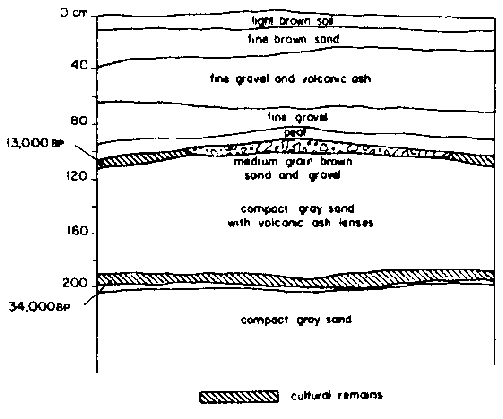 |
Science Frontiers ONLINE No. 57: May-Jun 1988 |
|
|
Updating man-in-the-americas
Referring back to SF#55, we find archeologist P.S. Martin quoted as saying:
"If humans lived in the New World more than 12,000 years ago, there'd be no secret about it."
This was from an article in which archeologists (some of them at least) were trying to roll forward the date at which humans entered the Americas from 12,000 to 11,500 years ago. In just a few months, we have collected four new items from the general scientific literature (not the U.S archeological literature!) that seem to be swimming against the current.
- The Meadowcroft Rockshelter. J.M. Adovasio and R.C. Carlisle, in a letter to Science, argue that better dating techniques have consistently pushed the date at which humans arrived in the New World. Using their own work at the Meadowcroft Rockshelter, in Pennsylvania, they cite many radiometric dates earlier than 12,000 years. At this Pennsylvania site, the six deepest dates definitely associated with cultural material indicate that humans were here
13,955 to 14,555 years ago.
(Adovasio, J.M., and Carlisle, Ronald C.; "The Meadowcroft Rockshelter," Science, 239:713, 1988.)
- Kansas River skeletal remains. Using electron-spin resonance to date a piece of a human skull, W. Dort and L.D. Martin affirm a date of 15,400 years before the present.
(Bower, B.; "Skeletal Aging of New World Settlers," Science News, 133: 215, 1988.)
- A Review of the Paleoindian Debate. W. Bray recounts in Nature what happened at a meeting at the Smithsonian last September. Various controversial sites were discussed, such as Calico Hills (200,000 years claimed) and Toca de Esperanca, Brazil (3,000,000 years claimed). But, oddly enough, the Meadowcroft Rockshelter and Kansas River data were not mentioned. Chiefly,
though, Bray was concerned with what did and what did not constitute generally acceptable proof in archeological dating. That this matter goes beyond idealized science is evident in Bray's quote of anthropologist E. Leach:
"Justification in terms of scientific methodology is in part self-deception, for when the figures turn out wrong the true believer will always shuffle the figures; when contrary evidence shows up, he throws doubt upon the credentials of the investigator."
(Bray, Warwick; "The Palaeoindian Debate," Nature, 332:107, 1988.)
- Monte Verde, Chile. We need quote here only the last two sentences of this paper's abstract:
"We report here two carbon-14 dates from charcoal taken from cultural features associated with the older materials of about 33,000 yr BP. These findings provide additional evidence that people colonized the Americas much earlier than previously thought."
(Dillehay, Tom D., and Collins, Michael B.; "Early Cultural Evidence from Monte Verde, Chile," Nature, 332:150, 1988.)
 |
Stratigraphy at Monte Verde, Chile. Human artifacts have been found in the 34,000 BP layer. |